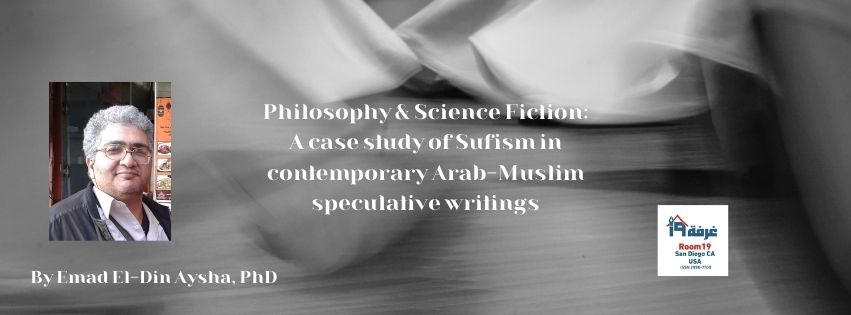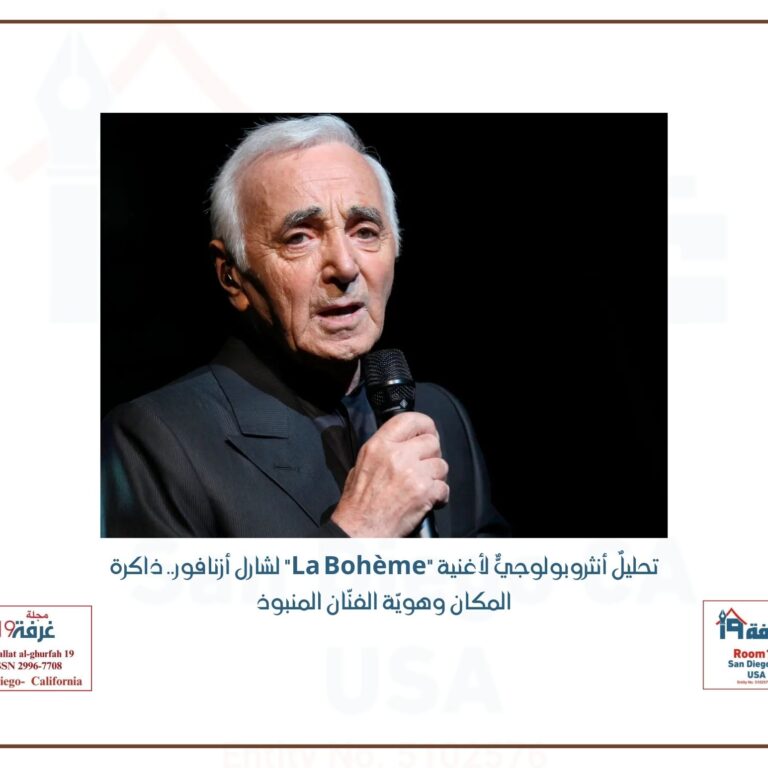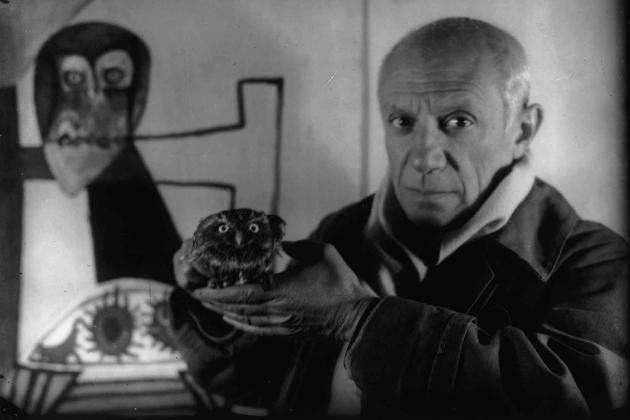
Trust in dreams, for in them is the hidden gate to eternity.
— Kahlil Gibran
Connecting philosophy to science fiction may seem a tall order. Philosophy has always been second nature to such genres as Surrealism and Magic Realism, and even Fantasy, but surely not SF? Science fiction is all about certainty, the reliability of scientific knowledge and the power of technology to conquer nature, with the blustering, self-confident alpha male explorer hero as the prototypical protagonist. Surrealism and co. are all about doubt and bending the laws of reality to suit your thematic intent. As tenuous as the link may seem, there is in fact a relationship between SF and philosophy, although the relationship seems more evident outside of the world of mainstream Anglophone SF.
The truth is that philosophy and any mode of storytelling have always been intimately linked, and from the very beginning. Philosophy begins with the Socratic Dialogues, true enough, but it also begins with Plato’s Analogy of the Cave. The two approaches, that of pure reason and that of allegory fuse in Plato’s Republic, or the vitreous city as we call it in Arabic, since the ideal city-state state in Plato’s imagination was quite literally modeled on the three levels of the soul as he saw it – reason, spirit and appetites. The republic is a living, breathing analogy. The function of each class (or caste) of people are meticulously argued and fleshed out through logical discourse but the inspiration for this setup again is analogical. The Republic moreover is an early example of world-building. No wonder then that fantastical literature has always had a healthy and prosperous relationship with philosophy, from Jonathan Swift’s Gulliver’s Travels (1726) to Kafka’s seminal The Metamorphosis (1915). Gene Roddenberry’s Star Trek itself was meant to be a 20th century example of Gulliver’s Travels, not so much as a wagon to the stars. Philip K. Dick was the grand Master of Philosophy in English-language SF, writing at the same level of Kafka and with much the same feel as can be witnessed in mind-bending classics like Time Out of Joint (1959), Martian Time-Slip (1964), Ubik (1969), A Maze of Death (1970), A Scanner Darkly (1977), Lies, Inc. (1984), etc. He also understood the art of metaphorical world-building guided by philosophical concerns, hence his masterpiece The Man in the High Castle (1962) with America divided into three zones. The Nazis on the East Coast, the Japanese to the West and the ‘neutral’ zone in the middle signifying how the America of his Cold War generation had to choose between the self-destructive tendencies of Western civilization and the Oriental philosophies and way of life that could guide them out of this nihilistic wilderness.
That being said, most SF isn’t philosophical, and philosophy is more at home with the aforementioned niche genres like Surrealism. That explains the success of people like Umberto Echo, Paulo Coelho and Jostein Gaarder, not to mention philosophers like Nietzsche and Kierkegaard who made worthy forays into fiction. It’s a daunting task in all cases and Philip K. Dick was the quintessential struggling and unrecognized artist, just like Kafka. Again, most mainstream SF isn’t philosophical, focusing on technological advance or the social and moral consequences of this advance. Witness wonderful stories like “Segregationist” (1967) by Isaac Asimov and “Jeffty Is Five” (1977) by Harlan Ellison, along with the Star Trek and Matrix franchises and series like Babylon 5 and the Battlestar Galactica reboot. There is philosophy in SF but SF doesn’t tend to be about philosophy. It tends not to pose ontological questions like the reality of numbers and if mathematical theorems actually correspond to the world out there, or the nature of identity in relation to memory and morality, consciousness and the reliability of knowledge, etc. PKD again is the big exception and movie adaptations of his works like Total Recall (1990), Minority Report (2002) and Blade Runner (1982).
Fortunately, other schools of science and speculative fiction are developing in the world and the one I’m going to talk about today, from the Arab and Muslim world, is very promising indeed when it comes to philosophy. The trailblazer here is Sufi speculative fiction; the demarcating lines between science and fantasy are not as distinct as in the West. We’re still the new kids on the block as far as science fiction and even the novel is a modern import into the Arab world. Nonetheless Arab and Muslim authors in the sci-fi and speculative realms are finding ways to splice philosophy into their writings, and in part by reviving our long and proud literary, religious and fantastical traditions.
Sources of the Speculative
Arabs and Muslims are steeped in philosophical resources, they just don’t know it. We have our own history of science-related moral parables[1] and fantastical storytelling – The City of Brass with its human statues in the 1001 Nights that are akin to Talos in Jason and the Argonauts (1963). We have our heritage before Islam, as many of the stories in 1001 Nights are actually Persian and Indian. We have the Epic of Gilgamesh from ancient Iraq and Kalila Wa Dimnah, Indian animal stories translated into Arabic. We have our religion as Muslims and our heritage of Quranic stories. We have angels, devils but also genies and Solomon’s magic and ability to speak the language of the animals, and the tale of the People of the Cave who slept for hundreds of years to find a world turned upside down. But I think most of all we have Sufism, a mind-bending genre if there ever was one, with universal appeal. And with that one of the best examples of proto-science fiction out there – Hayy ibn Yaqzan. Don’t take my word for it, ask sci-fi legend Philip José Farmer.[2] And he had a taste for philosophical stories too.
The story has many fathers – Ibn Sina, Ibn Tufail, Sahrawardi – but more to the point, the very construction of the hero is pure philosophy. Yaqzan means awake and Hayy means alive. Sufi dervishes, the mad variety who live on the streets, go around screaming hay, hay, meaning God is alive. So, the name is a reminder that God is here, present in your everyday troubles; you should never lose faith that He knows your sufferings and is Merciful for it. (Check out PKD’s The Cosmic Puppets [1957], where God the creator is one of the humans in the small-town setting of the novel, but has forgotten His powers and who He is, and only gets back into action after the humans stand up for Him and what is right and good). Yaqzan is a reference to consciousness, being ever alert to the world around you, inquisitive and scientific and – critically – skeptical. Hayy is smuggled to an island, according to one account, because he was born in secret from a princess who married a lowly knight. Another account however says he was created, spontaneously, as the rays of the sun worked their magic on the mud. In all cases he grows up on a deserted island, raised by a deer that took pity on him, and he grows up pure without human language or education. He educated himself, like a zoologist, dissecting animals and plants and then his mind begins to ponder the questions of physics and figures out the chain of causality – albeit on the Aristotelian model.
Even scholarship in the West has compared the Sufi parable to both the rationalism of Descartes and the empiricism of John Locke and their respective search for absolute truth.[3] Alas, this is a misreading of the great Sufi fable, to fit in with the philosophical-heritage of the West. Hayy starts off as a scientist but moves on from there to become a Muslim, praying five times a day, without knowledge of the Quran. Then he moves on to become a Sufi, doing a Sufi dance, swirling around himself in imitation of the motions of the heavenly spheres. Dancing with nature itself, God’s ultimate blessing. And that’s only the half of it. Sufis are mistrusting of both pure reason and the senses. They don’t so much balance Descartes and Locke as do away with the both of them by searching for certainty. Abu Hamid Al-Ghazali (1058-1111 AD) is the classic example of this. He wanted to reconcile philosophy with religion, and he found the answer in the heart. He famously lampooned pure reason through the story of the Hare and the Turtle and Arrow that never moves after being shot through the air, classic paradoxes from ancient Greek philosophy.[4] As for the senses, they lie to you all the time, even when you’re awake – let alone when you dream and you are confronted by an entirely plausible (virtual) reality that looks and feels real. These were no textbook concerns on the part of Al-Ghazali. He was living during tumultuous times, with a Muslim civil war between Sunnis and Shiites left their world at the mercy of the Crusaders to the West and the Mongols to the East.
In the meantime rationalist philosophers and theologists were getting us nowhere with their excessively theoretical debates – hairsplitting and nitpicking – while the jurists were textual literalists who were concerned with pandering to the elites. Al-Ghazali had started as a jurist himself raising from rags to riches and then had a crisis of conscience and spent the next ten years searching for the truth, pouring over the intellectual annals of his day from one mosque and city to the next.[5] People were quite literally in a state of radical doubting, with the walls of reality crashing down on them.[6] The answer lies is turning your back on society, living in solitude – for a time – and disciplining and taming the raging inferno you have beating within your own breast, and between your ears, through prayer and charity and piety, abstinence and fasting and religious chanting, etc. And then, through this process of cleansing, your heart will rise to the occasion and direct you down the right path. That is essentially what you see in Hayy ibn Yaqzan. Hayy was born in isolation, from society and language and education – all corrupting influences driven by power politics and hypocrisy and lies. His name again. He’s the progeny of God’s wisdom, like Adam, grown and shaped out of the mud. Pure and unsullied by the touch of civilization. That’s the ideal environment to become fully aware of the nature of things and your ability to utilize your rational faculties to study them, get true systematic knowledge. Doing your own self-financed research in effect.
This may sound like airy fairy mysticism to some, but it isn’t. Arabic as a language, and Islam as a religion, doesn’t admit to the mind-body problem that you find in modern Western philosophy and psychology. The term aql, which is usually translated as mind, is in fact a reference to the rational steering mechanism in your mind. Then there is the nafs, the soul, and then the rouh, the spirit. The spirit is what animates you, the ghost in the machine so to speak, but the soul is the result of the fusion of the spirit with the body. A cauldron of emotions and dark, subconscious forces. The Quran designates three categories of nafs – the kind that enjoins evil (possessed with envy and mistrust and hypocrisy), the guilty kind that torments you for your wrongdoing and evil thoughts, then finally the calm, reassured soul that knows it is on the right track and trusts in God’s mercy and divine plan. There is then the qalb, the heart, a term that is used in a way closer to the word conscience. We are told to take the fatwa, advice, of your heart even if the people all advise you otherwise.
Then there are ancillaries, fouad and wujdan, loosely translated as awareness and consciousness. Awareness is knowledge and information, and a reference to sight and certainty in a way. Wujdan is deeper, a kind of latent or implicit understanding of things that transmutes mere knowledge, over time, into wisdom.[7] It’s to do with the moral lessons you accumulate over time, through adversity and all the people and places you’ve seen and encountered. (The opposite of ‘false consciousness’, you could say). But more to the point, Hayy is the most well-known illustration of this layer cake of psychic forces, but not the most detailed. Here’s another example cited by Uzbek author in exile Hamid Ismailov:
… “Beauty and the Heart,” was a wonderful Sufi poem, a story with two parents. The father is Reason, and the mother is Love, and they give birth to a boy, Fouad, who is Heart. When the boy reaches 16, his mother presents him with a book, and in it he learns of the elixir of life, which comes from the lips of Passion, of Love. He then falls ill and wants to find this elixir, but his mother says to send his slave instead, Nazar, or “sight.” The slave follows the lights and goes to the world.
Once again, it is like Hayy ibn Yaqzan, a parable of the microcosm being the macrocosm. He visits the city of Wealth, Wellbeing, Curiosity, etc. … all the other cities that represent the different human capacities and struggles with the Passion. I had to translate 15,000 lines from Uzbek into Russian, that’s how I specialized myself, translating this wondrous literature that is so modern, more modern in fact than post-modern literature.
… Nazar travels through every human capacity. Reasoning, wit, and ultimately, he does find the elixir of life on the lips of Passion, and everything unites in the end.[8]
This is world-building on a grandiose scale, to recollect the example of Man in the High Castle, bringing us back to science fiction. A metaphorical construction of the world, physically embodying the themes you are exploring, something fantasy, science fiction and surrealism allows you to do in a way that realist fiction and social drama does not. (Star Trek has the Vulcans, Klingons and Ferengi, single-minded peoples who either embody reason, passion or greed, all in an effort to help humankind understand the conflicting faculties and desires that drive it).
Mr Ismailov also cites a Soviet-era borderline SF novel by a fellow Central Asian author, Begenas Sartov’s When the Edelweiss Flowers Flourish (1969):
The main character, Melis, meets at the crossroad of the world, Selim; the names are in reverse of each other. And it’s about their relationship, and the symbol of Edelweiss, which sorts out all their problems. It’s partly science fiction but is also partly Kirgiz folklore, because Kirgiz literature has epics. You have the Manas epic, which is the longest epic of the humankind. It is nearly 2 million verses, and it’s bigger than any other epic in the world. Forty times bigger than the Iliad and Odyssey, and therefore Kirgiz writers are very lucky to use all this wealth in their writings. He did the same, because Edelweiss is a flower that grows in the mountains there and has great symbolic power. It is the talisman of love; it is also a healing flower.[9]
And there is Hamid Ismailov’s own science or speculative fiction novel Of Strangers and Bees: A Hayy Ibn Yakzan Tale (2019). It centers on the original author of Hayy ibn Yaqzan, Ibn Sina, the great philosopher, medical doctor and Sufi. Legend has it that Ibn Sina was searching for the elixir of life but his students botched the job. Here he succeeds and becomes immortal, travelling through the great epochs of history like the Tulip era in Ottoman Turkey and the art world of Renaissance Italy, till he reaches the modern world and gets arrested by the Americans – an illegal alien or terror suspect – in Hanger 51, of Roswell fame!
The Arab as Philosopher
This ‘sensibility’ can be found in Arabic SF, even if it isn’t explicitly spiritual or Sufi-themed SF. Nihad Sharif (1932-2011), the dean of Arabic science fiction, was terrified of nuclear war between the Western and Eastern camps and he saw this as resulting from tremendous technological arrogance on the part of the modern world. This comes out in his classics, Number 4 Warns You (1974) and The Residents of the Other World (or Second World, 1977). In the first novel, Martians warn Earth about nuclear war and how the fifth planet in the solar system was destroyed by a nuclear war, turning it into the asteroid belt. The poor Martians themselves have to live underground in a parched desert planet because of this. When Earth ignores this warning, the Martians send a cloud to wipe out the memories of nuclear physics in people’s minds. The Residents novel is a Utopian story about a band of rebel scientists, protesting against nuclear war, who set up a colony at the bottom of the ocean and try to blackmail the earth powers into giving up their nuclear weapons. Sadly the Earth powers gang up on the colony and almost destroy all its residents.
Note that while Nihad Sharif did not tackle spiritual themes head on, he was quite a hard sci-fi writer, the political system in his own version of the virtuous city was a hybrid system – combing French law and Islamic sharia. That’s a big deal if you’re an Egyptian. Since Napoleon’s campaign in Egypt and Champollion’s decoding of hieroglyphs, Egyptians have seen in French law – French republic, revolution, art, literature, etc. – their salvation. But at the same time, they want to be true to their roots and maintain their family life and traditional values, and see Western life and modernity as cold and lonely and often at odds with nature. Much early Egyptian and Arabic science fiction generally had the same misgivings about science and modernity that Mary Shelly had in Frankenstein, with scientists playing God and tampering with the very stuff of nature, and God’s will.[10] So there’s a spiritualist and philosophical undercurrent, in the background, if not mysticism as such.
Someone who foregrounded his mystical credentials, and often explicitly incorporated Sufism, was Mustafa Mahmoud (1921-2009), an Islamic thinker who tried his hand at writing novels and plays in the 1960s. He was also an early pioneer of Egyptian SF with The Spider (1967), Out of the Coffin (1967), A Man Under Zero (1967) and Opium (1976).[11] The Spider is a murder mystery where a medical doctor tracks down a patient of his who is accessing genetic memories from within the brain, taking you down a journey backwards in time like the movie Altered States (1980). The doctor comes to his own doom, not being able to withstand the temptation of reincarnation, the forbidden knowledge of living other people’s and things’ lives in the past and journeying back to the very inception of the universe. Out of the Coffin involves reincarnation, from ancient Egypt, and begins in India with a mystic who has supernatural powers like levitation and who can commune with the dead. Man Under Zero is a Utopia/dystopia novel about a near perfect future world where all material pleasures are allowed by a universalist world order resulting from the aftermath of a nuclear war and horrendous post-apoc plague. But there’s no religion and true love in this world and we are told early on that we’re all doomed, because the universe has begun to contract. Not that it dents anyone’s enthusiasm for sex and drugs and stealing other men’s wives. The hero is a scientist struggling with these eventualities, on account of his religious and loving wife, then he finds a way to transform himself into electromagnetic radiation and journeys across the solar system. In the penultimate scene he goes to the core of the sun and burns up. He feels like he’s returning to the origin of the universe, and meeting God. He broadcasts his message back to mankind and apologizes to his wife and their child – but his message falls on deaf ears. (There’s a connection to Hayy ibn Haqzan in the novel’s folds that often goes unnoticed, since they discover non-organic life forms in the story – rocks that grow and multiply). Opium is about a Sufi devotee, a poor man who is slowly going mad from the demands of life and the corrupt people who rise to the top through their hypocrisy and theft. Not coincidentally the man’s brother is such a corrupt official, working in a Nasserist socialist project meant to redistribute wealth, and his son is a Marxist who hates Sufis only to learn that they have supernatural powers afforded to them by their faith and purity.
There’s philosophy strewn in the midst of all of this too, as Marxism means dialectic materialism and harsh Godless scientism. The universe contracting questions the utility of science in the long run if we’re all doomed. The man who steals the genetic memories goes as far as killing to get what he wants, the chance to live other people’s lives and partake of the illusion of immortality. (The patient, when he’s dying in the doctor’s arms, justifies what he did by saying he didn’t kill anybody but instead gave them life – hundreds of thousands of other lives). Indian spiritualism lets you do what science doesn’t let you do and reviving an ancient Egyptian Pharaoh means access to a civilization just as advanced as ours.
Sadly, Mustafa Mahmoud was the exception to the rule and promptly gave up writing, saddling us for far too long with Arab SF that was either too hostile to modern science, or mindlessly aped Western SF. Thankfully contemporary Egyptian SF, from the turn of the century, is reasserting its spiritual credentials. In a parallel universe novel, Akwan (Universes, 2017) by Wael and Mahmoud Abdel Rahim, you have an Egyptian scientist working for the Americans who is trying to open the pan-dimensional portal that is the Bermuda Triangle and almost creates a war between the different alien races living on alternate Earths. The scientist himself is the son of a sheikh who does battle with evil spirits using the Quran and warned his son against his scientific arrogance. And the scientist sells his soul to the Americans and their military experiments, after all, only ever financing science when it’s for destructive purposes. Dr. Hosam Elzembely, the founder and director of the Egyptian Society for Science Fiction (ESSF), has a number of interesting YA novels with spiritual themes or elements. The Half-Humans (2001) has Muslim space farers in the distant future rescuing a dying breed of aliens and in the process, they are gifted with a new crew member, a biological android (a metal frame filled with reconstituted tissues that is battery-powered nonetheless). The hero slowly finds himself being drawn to her, even though she’s technically a toaster, and she shows great volition and courage, saving the lives of the human crew more than once and sacrificing herself in the process. In an interview about the novel, Dr. Hosam admitted that she has a soul, on account of verses in the Quran that indicate that everything – even inanimate objects – have some kind of residual consciousness and worship God in their own special way.[12] In his novel The Planet of the Viruses (2001), a herpes epidemic threatens to blind all humanity and the Muslim scientist tasked with finding a cure, Dr. Saladin, realizes that the disease is trying to communicate with them. Its sentient, an alien virus that needs man’s help to defeat a tyrant on its home world.
The closing scene is very moving, with Dr. Saladin using a translation device and noticing oddities in the way the viruses are saying thank you and farewell. They’re crying. In the early stages of the pandemic Dr. Saladin also has a dream where he sees the Prophet Muhammad and he tells him in no uncertain words that he will find the cure. His faith is tested afterwards when his own mother is infected and loses her sight, but his colleagues’ faith in his scientific abilities and leadership skills wins out in the end. His latest YA novel The Final Voyage (2023) is set on Mars after disasters befall mankind on Earth. The would-be colonists on the red planet come into contact with sentient aliens, including crystalline (non-organic, inanimate) life forms. There’s also two AI robots who beat the humans to Mars, and show more ingenuity and enthusiasm than mankind. By pure coincidence their inventor found a way to override Asimov’s three laws by pushing them along the path of self-awareness and individual consciousness, and with that a moral emphasis on conscience through doing battle with the self. Some of the robots begin to wonder out loud if they have souls and if they should pray to God or some other creator!
An extra name to this list would be Ammar Al-Masry. While not cordial to Sufism – he’s a friend and tells me so – he has the world of the soul aplenty in his novels. He writers borderline SF, using motifs from fantasy literature (Arab and Western), as well as super science and in his novel Cosmic Shock: The Black Angel (2021), you also have a pan-dimensional portal that human scientists are toying with, wreaking havoc on their city once they take a step too far. There’s a lot of Stephen King’s The Mist in here but more importantly are the East vs. West, and spiritualism vs. materialism conversations that take place amongst the scientists and how even the pious Muslim scientist has pushed it too far by trying to prove the existence of the soul and see the hidden world of jinn and discern God’s plan for us.
The only catch is that these are YA novels so naturally they don’t have the same level of psychological and philosophical sophistication that you find in Hamid Ismailov or Begenas Sartov. But it’s a start and there is the odd stellar exception. One such exception is Djamel Jiji, a fantasy writer from Algeria with his novel The Invaders of Dreams (2009). A village is under constant bloodthirsty attack by occupation forces in an unnamed Arab land – a clear allusion to Palestine and Iraq – and the heroine, Jasmine, escapes into a fantasy storyline to cope with the tragedy and loss. But even in this fantasy world all is not well, with the evil King Walker (like W. Bush) trying to conquer the realm of dreams, first through weapons of mass destruction and then through black magic, with a witch’s apprentice sent to penetrate the ranks of the angelic kingdom to corrupt them from the inside out. It works at first but then the apprentice girl herself is converted to good. By the end of the story, we return to the real world, where the villagers are slaughtered but nonetheless you feel that the fantasy world Jasmine created will sustain itself beyond this one, since truth wins out in the end when you meet evil with mercy and don’t sink to the level of your enemy.
The sequel, The Return of Jesus (2015), has the second coming of Christ and with those explicit questions about the problem of evil, why the innocent suffer at the hands of the evil and unjust – the central if implicit thematic of the first novel. Cruelty and injustice exist to prove that right is right and will win out in the end because even the evil doers know what is right. There’s plenty of Sufism in the second novel and the philosophical mindset is certainly evident in Invaders of Dreams; questioning what’s real and what isn’t. Alas, these are fantasy novels, not SF, but its speculative fiction and PKD famously wrote borderline SF far more than hard SF. If you believe in the mystical, such as alternate realities mapped out by the Chinese book of changes, the definitions of what is science and what is fantasy begin to blur anyway!
Other more substantive novels include the works of Moussa Ould Ebnou, a man schooled in philosophy who also incorporates Sufism into the mystical journeys of the afterlife with death and the entry of the soul into body with birth.[13] In Egypt there is also Ihab Muhammad Ziyad’s play, printed in novel-form, Bimaristan Al-Rouh (2014) or Hospital of the Soul (or spirit, as the terms are used interchangeably in colloquial Arabic). Here a blight has infected the crops and livestock in Egypt, even turning man against man, and the government and scientific establishment is struggling to find a cure. A brave scientist named Hassan Al-Sufi realizes that it is the genes of the Egyptians that have been corrupted and are now infecting everything else, so pure DNA samples from the mummies of the ancients – and also their preserved crops – will save the day. Then there is Emad Bakr’s highly innovative, satirical and self-published novel The City of Honka Ponka Combats Atheism and Corruption (2015).[14] Here you have a narrative voice, a storyteller on the old Arabic model, telling the reader about this made up city that you can tell is Cairo and by extension Egypt, inserting two fictional heroes into this city landscape to figure out what’s ailing the people of this half-made up world. The narrator tells you that Honka Ponka is no virtuous city, and that people console themselves with the love of their families, values and noble history. The duo is the naughty and nice person, similar to the duo of Salman and Absal you find in Ibn Tufayl’s version of Hayy ibn Yaqzan, and they in turn encounter a curious couple, an old, ugly philosopher who is a heavy drinker and his lovely, sleek and sexy young wife. By the end of the story the two heroes learn that these are physical embodiments of the cosmic forces of negative and positive energy, and they are toying with the deteriorating reality of the city – corruption and nepotism and opportunism – from behind the scenes.
The city is as motif for a country or even a world, on the old city-state and Platonic republic model – as you can see in movies like Æon Flux (2005) and Logun’s Run (1976). We have our own version of Plato in Islamic history, Al-Farabi’s Book of the Opinions of the Inhabitants of the Virtuous City in the 10th century, hence the quip about the opening of Bakr’s novel. I should also mention the works of Iraj Fazel Baksheshi from Iran. While not Sufi they certainly are philosophical and blend myths into hard science in his stories “Yalda” (2018) and “New Day” (2014). (One exception is “Ice Cream Cone” [2014], with a Sufi poem by Saadi read at the end).[15] Evolution is another key philosophical theme in his stories, something that both challenges traditional understandings of religion in the East but also poses moral-existential questions for the West – is evolution progress and is material advance more important or the cultivation of the self and with that living in balance with nature? These are most evident in his novella A Message Older than Time (2007), where miners stumble on a recorded message from an older intelligent race that once ruled the Earth, till the meteorite that exterminated the dinosaurs collides with our planet. His dystopian novella Humans and Skyscrapers (2005) is also about a regimented, industrialized world of isolation where the soul is downgraded through the neglect of family attachments and drugs that dull the intelligence and hiding history and art from the citizenry.
A Parting Example
Philosophy is clearly very high on the agenda of Arab and Muslim SF, with works tackling key philosophical dilemmas instead of philosophy being a byproduct of moral dilemmas route on by technological progress. Modernity is an import into our part of the world, and we are constantly worried if we can be true to ourselves, our religious beliefs and traditional way of living and cultural identity, and so we write a great deal of science fiction about philosophy instead of just SF with philosophy ‘in’ it.
For a final illustration we Dr. Faycel Lahmeur, an Algerian writer, academic and poet. He has a new novel in the works that is hard SF but takes a Sufi philosophical angel, The City of Saint Augustus (or Augustine), which blends together esoteric and mystical traditions from all three monotheistic religions, with an emphasis of course on Jalal din Rumi and Ibn Arabi. Dr. Faycel has also published In the Forgotten Dimension (2022), a nominal space opera set in the distant future after humans have terraformed and colonized planets in the solar system and use black holes to travel further afield and transform new, stranger worlds. The hero – Malik, which means king – is on one of the new planets, that is the double ganger of Earth as far as the continents and oceans are concerned. Only the planet’s diurnal motion is different. He and his family and friends have good jobs and live a life of robotically assisted luxury. The catch is with that cyborg technology you begin to suspect who is human and who is not, especially when he finds that friends and colleagues can’t remember certain things they should know by virtue of their relationships with him. AI’s are practically in control of everything – education, the law, travel permits – and the hero rebels and heads back to Earth with the help of pirates, via black hole. He leaves instructions to his wife to join him, and she does. When he gets back to his hometown in Algeria, up in the hills with lush greenery and citrus fruits and clean fresh air, he finds it’s all gone and become an urban morass, filled again with robotic strictures. He forgot about time dilation. He gets arrested, for being a non-conformist and can only get out with the help of a psychiatrist who convinces the authorities he’s his patent, and Malik’s loving but exasperated wife eventually makes it to him too. (He’s the quintessential stubborn Arab intellectual and only her love forgives him his eccentricities; she’s his conscience and the person who keeps him firmly rooted to this life). Fortunately, the prison sentence, and time dilation, work to his advantage. While in his solitude, with the AIs cunningly trying to drive him crazy by shifting and altering the dimensions of his cell, and his sense of time, he relies on the writings of a Sufi mystic to maintain his sanity and even turn the tables on his captors.
Solitary confinement may be punishment to others but to a pious Muslim it’s the opportunity to get away from it all, live like the Prophet in the cave of Hiraa, and focus on prayer and the Quran and riyadat al-nafs – exercises of the soul, a classic Sufi stratagem. He begins to develop paranormal powers, karamat in Sufi lingo, and when robots and drones try to capture him once he’s on the outside he can use his powers to deflect them. Also, having been away for so long through the black hole, his legend as a rebel has grown and captivated people, giving him followers. He finally goes up in the mountain tops, just like the Prophet in his early days after the first revelation, trying to get closer to God in the heavens and discover his divine mission.
Malik’s mission is to return to nature and combat against climate change and the mechanization of life, but the journey is all premised on Sufi parables. Time games are very familiar to Arabs and Muslims because of the Israa and Miraj or the Night Journey and Ascension of the Prophet from Mecca to Jerusalem and up into the Heavens, all in the blink of an eye to the point that his bed was still warm when he got back. (The Night Journey is a favourite of Sufis and was deployed repeatedly by them as an instrument of salvation for the masses, putting them in contact with Allah on the model of the Prophet). There is also the Quranic story of the throne of Bilqees, Queen of Sheba, and how the Prophet Solomon commanded the jinn to bring it to him immediately with rival offers as to who was faster. And there is the story of the People of the Cave, who escaped persecution, hid in a cave and fell asleep only to wake up hundreds of years later, like Rip Van Winkel. (There is another story like that in the Quran, where a man is catapulted into the future and is forced to mistrust his senses, since he finds his food and drink are fine, but his donkey has turned to dust. He has to trust in God or otherwise he will go mad). And what set Malik down this journey to begin with was paranoia in a future world where nothing is what seems.
Eat your heart out Descartes. This is possibly the last great contribution Sufi speculative fiction can make to the global cannon of SF, namely, reconciling religion with scientific advance – with philosophy as the glue. The West has put its religious heritage behind it since the scientific revolution in the 17th century and in the process forgotten its own history. Revolutionary thinkers like Descartes were profoundly religious people. Newton was a Unitarian and alchemist and believed that God periodically interfered in the universe to stop the planets falling into the sun. He wasn’t as much a proponent of the Clockwork Universe as we think, and that whole notion comes from a philosopher like Descartes to begin with. Radical doubting is actually a religious exercise as much as it is philosophical and Arab-Muslim SF can help the West remember its own past better and move on into the future in better shape than before. From that point onward the opportunities for crosspollination, splicing Western with non-Western SF, are limitless.
[1] There more science and technology in The 1001 Nights than people realize. Please see Kawthar Ayed, “Mapping the Maghreb: The History and Prospects of SF in the Arab West”, Arab and Muslim Science Fiction: Critical Essays, edited by Hosam A. Ibrahim Elzembely and Emad El-Din Aysha, (Jefferson, North Carolina: McFarland, 2022), pp. 21-22.
[2] Farmer, “‘Hayy ibn Yaqzam’ by Abu ibn Tufayl: An Arabic Mowgli”, Journal of the Fantastic in the Arts, vol. 3, no. 3/4 (11/12), The Lost Issues, 1994, pp. 72-78.
[3] Fabio López Lázaro, “The Rise and Global Significance of the First ‘West’: The Medieval Islamic Maghrib”,
Journal of World History, Vol. 24, No. 2, June 2013, pp. 289.
[4] Please see Abdel Halim Mahmoud, The Case of Sufism: Al-Munqiz Min Al-Dalaal, (Cairo: Dar al-Maraif, 2020, 9th edition), pp. 197-198. [Arabic]
[5] Mahmoud, The Case of Sufism, pp. 271-272.
[6] Faisal Badir Aoun, Islamic Philosophy in the East, (Cairo: Dar Al-Thaqafa for Publishing and Distribution, 1982), pp. 383-385. [Arabic]
[7] Just look at this Rumi quote: “Experience shows that the spirit is nothing but awareness. Whoever has greater awareness has greater spirit…When the spirit becomes greater and passes beyond all bounds, the spirits of all things become obedient to it.” It’s like you’re watching the sci-fi movie Lucy (2014)!
[8] “Hamid Ismailov on the Remnants of Central Asian Fantasy and Science Fiction”, Arab and Muslim Science Fiction: Critical Essays, edited by Hosam A. Ibrahim Elzembely and Emad El-Din Aysha, (Jefferson, North Carolina: McFarland, 2022), pp. 222.
[9] “Hamid Ismailov on the”, pp. 223.
[10] Please see Ian Campbell’s articles “False gods and libertarians: Artificial intelligence and community in Aḥmad ‘Abd al-Salām al-Baqqāli’s The Blue Flood and Heinlein’s The Moon is a Harsh Mistress,” Science Fiction Studies, vol. 44, no. 1, 2017, pp. 43-64, and “Science fiction and social criticism in Morocco of the 1970s: Muhammad Aziz Lahbabi’s The Elixir of Life,” Science Fiction Studies, vol. 42, no. 1, 2015, pp. 42-55.
[11] For an extended discussion of the evolution of Arab SF, and with that Mustafa Mahmoud’s moral and spiritual concerns, please see Barbara K. Dick, “Under the Microscope: An Academic Appraisal of the Evolving Milieu of Arab SF”, Arab and Muslim Science Fiction: Critical Essays, edited by Hosam A. Ibrahim Elzembely and Emad El-Din Aysha, (Jefferson, North Carolina: McFarland, 2022), pp. 352-366.
[12] Elzembely. Cultural Salon for the Egyptian Society for Science Fiction. Nasr City, Egypt. 27 October 2017. [Arabic]
[13] Ebnou, “The Expanse of Mauritanian SF: Tuning French to a Future Informed by the Past”, Arab and Muslim Science Fiction: Critical Essays, edited by Hosam A. Ibrahim Elzembely and Emad El-Din Aysha, (Jefferson, North Carolina: McFarland, 2022), pp. 276, 281.
[14] The publishing house responsible for Bimaristan Al-Rouh has gone bankrupt, sadly, through no wrongdoing of Ihab Muhammad Ziyad’s of course!
[15] Please visit Mr Iraj’s facebook page to read English, Arabic and Persian versions of his stories: https://www.facebook.com/MyScienceFictionStories?mibextid=ZbWKwL.





